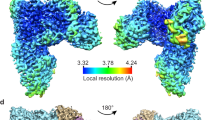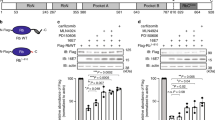Abstract
In vitro, high-risk human papillomavirus E6 proteins have been shown, in conjunction with E6-associated protein (E6AP), to mediate ubiquitination of p53 and its degradation by the 26S proteasome by a pathway that is thought to be analogous to Mdm2-mediated p53 degradation. However, differences in the requirements of E6/E6AP and Mdm2 to promote the degradation of p53, both in vivo and in vitro, suggest that these two E3 ligases may promote p53 degradation by distinct pathways. Using tools that disrupt ubiquitination and degradation, clear differences between E6- and Mdm2-mediated p53 degradation are presented. The consistent failure to fully protect p53 protein from E6-mediated degradation by disrupting the ubiquitin-degradation pathway provides the first evidence of an E6-dependent, ubiquitin-independent, p53 degradation pathway in vivo.
This is a preview of subscription content, access via your institution
Access options
Subscribe to this journal
Receive 50 print issues and online access
$259.00 per year
only $5.18 per issue
Buy this article
- Purchase on Springer Link
- Instant access to full article PDF
Prices may be subject to local taxes which are calculated during checkout







Similar content being viewed by others
References
Benaroudj N, Tarcsa E, Cascio P, Goldberg AL . (2001). The unfolding of substrates and ubiquitin-independent protein degradation by proteasomes. Biochimie 83: 311–318.
Bercovich Z, Kahana C . (1993). Involvement of the 20S proteasome in the degradation of ornithine decarboxylase. Eur J Biochem 213: 205–210.
Camus S, Higgins M, Lane DP, Lain S . (2003). Differences in the ubiquitination of p53 by Mdm2 and the HPV protein E6. FEBS Lett 536: 220–224.
Chen X, Chi Y, Bloecher A, Aebersold R, Clurman BE, Roberts JM . (2004). N-acetylation and ubiquitin-independent proteasomal degradation of p21(Cip1). Mol Cell 16: 839–847.
Chowdary DR, Dermody JJ, Jha KK, Ozer HL . (1994). Accumulation of p53 in a mutant cell line defective in the ubiquitin pathway. Mol Cell Biol 14: 1997–2003.
Coffino P . (2001). Antizyme, a mediator of ubiquitin-independent proteasomal degradation. Biochimie 83: 319–323.
Courtois S, Verhaegh G, North S, Luciani MG, Lassus P, Hibner U et al. (2002). DeltaN-p53, a natural isoform of p53 lacking the first transactivation domain, counteracts growth suppression by wild-type p53. Oncogene 21: 6722–6728.
Crook T, Ludwig RL, Marston NJ, Willkomm D, Vousden KH . (1996). Sensitivity of p53 lysine mutants to ubiquitin-directed degradation targeted by human papillomavirus E6. Virology 217: 285–292.
Dalal S, Gao Q, Androphy EJ, Band V . (1996). Mutational analysis of human papillomavirus type 16 E6 demonstrates that p53 degradation is necessary for immortalization of mammary epithelial cells. J Virol 70: 683–688.
Foster SA, Demers GW, Etscheid BG, Galloway DA . (1994). The ability of human papillomavirus E6 proteins to target p53 for degradation in vivo correlates with their ability to abrogate actinomycin D-induced growth arrest. J Virol 68: 5698–5705.
Gardiol D, Banks L . (1998). Comparison of human papillomavirus type 18 (HPV-18) E6-mediated degradation of p53 in vitro and in vivo reveals significant differences based on p53 structure and cell type but little difference with respect to mutants of HPV-18 E6. J Gen Virol 79: 1963–1970.
Ghosh A, Stewart D, Matlashewski G . (2004). Regulation of human p53 activity and cell localization by alternative splicing. Mol Cell Biol 24: 7987–7997.
Glickman MH, Ciechanover A . (2002). The ubiquitin–proteasome proteolytic pathway: destruction for the sake of construction. Physiol Rev 82: 373–428.
Glockzin S, Ogi FX, Hengstermann A, Scheffner M, Blattner C . (2003). Involvement of the DNA repair protein hHR23 in p53 degradation. Mol Cell Biol 23: 8960–8969.
Harris SL, Levine AJ . (2005). The p53 pathway: positive and negative feedback loops. Oncogene 24: 2899–2908.
Haupt Y, Maya R, Kazaz A, Oren M . (1997). Mdm2 promotes the rapid degradation of p53. Nature 387: 296–299.
Hengstermann A, D'silva MA, Kuballa P, Butz K, Hoppe-Seyler F, Scheffner M . (2005). Growth suppression induced by downregulation of E6-AP expression in human papillomavirus-positive cancer cell lines depends on p53. J Virol 79: 9296–9300.
Honda R, Tanaka H, Yasuda H . (1997). Oncoprotein MDM2 is a ubiquitin ligase E3 for tumor suppressor p53. FEBS Lett 420: 25–27.
Hoyt MA, Zhang M, Coffino P . (2005). Probing the ubiquitin/proteasome system with ornithine decarboxylase, a ubiquitin-independent substrate. Methods Enzymol 398: 399–413.
Huibregtse JM, Scheffner M, Howley PM . (1993). Cloning and expression of the cDNA for E6-AP, a protein that mediates the interaction of the human papillomavirus E6 oncoprotein with p53. Mol Cell Biol 13: 775–784.
Hupp TR, Meek DW, Midgley CA, Lane DP . (1992). Regulation of the specific DNA binding function of p53. Cell 71: 875–886.
Hwang SG, Yu SS, Ryu JH, Jeon HB, Yoo YJ, Eom SH et al. (2005). Regulation of beta-catenin signaling and maintenance of chondrocyte differentiation by ubiquitin-independent proteasomal degradation of alpha-catenin. J Biol Chem 280: 12758–12765.
Jin Y, Lee H, Zeng SX, Dai MS, Lu H . (2003). MDM2 promotes p21waf1/cip1 proteasomal turnover independently of ubiquitylation. EMBO J 22: 6365–6377.
Ju D, Xie Y . (2004). Proteasomal degradation of RPN4 via two distinct mechanisms, ubiquitin-dependent and -independent. J Biol Chem 279: 23851–23854.
Kahana C, Reiss Y . (2005). Cell-free assay for ubiquitin-independent proteasomal protein degradation. Methods Mol Biol 301: 83–96.
Kalejta RF, Shenk T . (2003). Proteasome-dependent, ubiquitin-independent degradation of the Rb family of tumor suppressors by the human cytomegalovirus pp71 protein. Proc Natl Acad Sci USA 100: 3263–3268.
Kelley ML, Keiger KE, Lee CJ, Huibregtse JM . (2005). The global transcriptional effects of the human papillomavirus E6 protein in cervical carcinoma cell lines are mediated by the E6AP ubiquitin ligase. J Virol 79: 3737–3747.
Kretz-Remy C, Arrigo AP . (2003). Modulation of the chymotrypsin-like activity of the 20S proteasome by intracellular redox status: effects of glutathione peroxidase-1 overexpression and antioxidant drugs. Biol Chem 384: 589–595.
Kubbutat MH, Ludwig RL, Ashcroft M, Vousden KH . (1998). Regulation of Mdm2-directed degradation by the C terminus of p53. Mol Cell Biol 18: 5690–5698.
Lagrange M, Charbonnier S, Orfanoudakis G, Robinson P, Zanier K, Masson M et al. (2005). Binding of human papillomavirus 16 E6 to p53 and E6AP is impaired by monoclonal antibodies directed against the second zinc-binding domain of E6. J Gen Virol 86: 1001–1007.
Lechner MS, Laimins LA . (1994). Inhibition of p53 DNA binding by human papillomavirus E6 proteins. J Virol 68: 4262–4273.
Li X, Coffino P . (1996a). High-risk human papillomavirus E6 protein has two distinct binding sites within p53, of which only one determines degradation. J Virol 70: 4509–4516.
Li X, Coffino P . (1996b). Identification of a region of p53 that confers lability. J Biol Chem 271: 4447–4451.
Li X, Lonard DM, Jung SY, Malovannaya A, Feng Q, Qin J et al. (2006). The SRC-3/AIB1 coactivator is degraded in a ubiquitin- and ATP-independent manner by the REGgamma proteasome. Cell 124: 381–392.
Liu Y, Chen JJ, Gao Q, Dalal S, Hong Y, Mansur CP et al. (1999). Multiple functions of human papillomavirus type 16 E6 contribute to the immortalization of mammary epithelial cells. J Virol 73: 7297–7307.
Nakamura S, Roth JA, Mukhopadhyay T . (2002). Multiple lysine mutations in the C-terminus of p53 make it resistant to degradation mediated by MDM2 but not by human papillomavirus E6 and induce growth inhibition in MDM2-overexpressing cells. Oncogene 21: 2605–2610.
Ness GC, Holland RC . (2005). Degradation of HMG-CoA reductase in rat liver is cholesterol and ubiquitin independent. FEBS Lett 579: 3126–3130.
Nomine Y, Masson M, Charbonnier S, Zanier K, Ristriani T, Deryckere F et al. (2006). Structural and functional analysis of E6 oncoprotein: insights in the molecular pathways of human papillomavirus-mediated pathogenesis. Mol Cell 21: 665–678.
Pena MM, Xing YY, Koli S, Berger FG . (2005). Role of N-terminal residues in the ubiquitin-independent degradation of human thymidylate synthase. Biochem J 394: 355–363.
Rolfe M, Beer-Romero P, Glass S, Eckstein J, Berdo I, Theodoras A et al. (1995). Reconstitution of p53-ubiquitinylation reactions from purified components: the role of human ubiquitin-conjugating enzyme UBC4 and E6-associated protein (E6AP). Proc Natl Acad Sci USA 92: 3264–3268.
Rosenberg-Hasson Y, Bercovich Z, Ciechanover A, Kahana C . (1989). Degradation of ornithine decarboxylase in mammalian cells is ATP dependent but ubiquitin independent. Eur J Biochem 185: 469–474.
Saeki Y, Isono E, Oguchi T, Shimada M, Sone T, Kawahara H et al. (2004). Intracellularly inducible, ubiquitin hydrolase-insensitive tandem ubiquitins inhibit the 26S proteasome activity and cell division. Genes Genet System 79: 77–86.
Salvat C, Acquaviva C, Scheffner M, Robbins I, Piechaczyk M, Jariel-Encontre I . (2000). Molecular characterization of the thermosensitive E1 ubiquitin-activating enzyme cell mutant A31N-ts20Requirements upon different levels of E1 for the ubiquitination/degradation of the various protein substrates in vivo. Eur J Biochem 267: 3712–3722.
Scheffner M . (1998). Ubiquitin, E6-AP, and their role in p53 inactivation. Pharmacol Ther 78: 129–139.
Scheffner M, Huibregtse JM, Howley PM . (1994). Identification of a human ubiquitin-conjugating enzyme that mediates the E6-AP-dependent ubiquitination of p53. Proc Natl Acad Sci USA 91: 8797–8801.
Scheffner M, Huibregtse JM, Vierstra RD, Howley PM . (1993). The HPV-16 E6 and E6-AP complex functions as a ubiquitin-protein ligase in the ubiquitination of p53. Cell 75: 495–505.
Scheffner M, Werness BA, Huibregtse JM, Levine AJ, Howley PM . (1990). The E6 oncoprotein encoded by human papillomavirus types 16 and 18 promotes the degradation of p53. Cell 63: 1129–1136.
Sdek P, Ying H, Chang DL, Qiu W, Zheng H, Touitou R et al. (2005). MDM2 promotes proteasome-dependent ubiquitin-independent degradation of retinoblastoma protein. Mol Cell 20: 699–708.
Stewart D, Ghosh A, Matlashewski G . (2005). Involvement of nuclear export in human papillomavirus type 18 E6-mediated ubiquitination and degradation of p53. J Virol 79: 8773–8783.
Tofaris GK, Layfield R, Spillantini MG . (2001). Alpha-synuclein metabolism and aggregation is linked to ubiquitin-independent degradation by the proteasome. FEBS Lett 509: 22–26.
Xirodimas D, Saville MK, Edling C, Lane DP, Lain S . (2001). Different effects of p14ARF on the levels of ubiquitinated p53 and Mdm2 in vivo. Oncogene 20: 4972–4983.
Yin Y, Stephen CW, Luciani MG, Fahraeus R . (2002). p53 Stability and activity is regulated by Mdm2-mediated induction of alternative p53 translation products. Nat Cell Biol 4: 462–467.
zur Hausen H . (2000). Papillomaviruses causing cancer: evasion from host-cell control in early events in carcinogenesis. J Natl Cancer Inst 92: 690–698.
Acknowledgements
This work was supported by Cancer Research UK and by the generosity of Reverend and Mrs Cameron through the Kitty Cameron Fund. We thank D Coomber for help with the manuscript preparation and M Scheffner for advice and reagents at the project outset.
Author information
Authors and Affiliations
Corresponding author
Additional information
Supplementary Information accompanies the paper on the Oncogene website (http://www.nature.com/onc).
Rights and permissions
About this article
Cite this article
Camus, S., Menéndez, S., Cheok, C. et al. Ubiquitin-independent degradation of p53 mediated by high-risk human papillomavirus protein E6. Oncogene 26, 4059–4070 (2007). https://doi.org/10.1038/sj.onc.1210188
Received:
Revised:
Accepted:
Published:
Issue Date:
DOI: https://doi.org/10.1038/sj.onc.1210188
Keywords
This article is cited by
-
Upregulation of wild-type p53 by small molecule-induced elevation of NQO1 in non-small cell lung cancer cells
Acta Pharmacologica Sinica (2022)
-
Two-Step Mechanism of Cyclin B Degradation Initiated by Proteolytic Cleavage with the 26 S Proteasome in Fish
Scientific Reports (2020)
-
Co-expression of MDM2 and CDK4 in transformed human mesenchymal stem cells causes high-grade sarcoma with a dedifferentiated liposarcoma-like morphology
Laboratory Investigation (2019)
-
NDRG2 contributes to cisplatin sensitivity through modulation of BAK-to-Mcl-1 ratio
Cell Death & Disease (2018)
-
Ubiquitination involved enzymes and cancer
Medical Oncology (2014)



